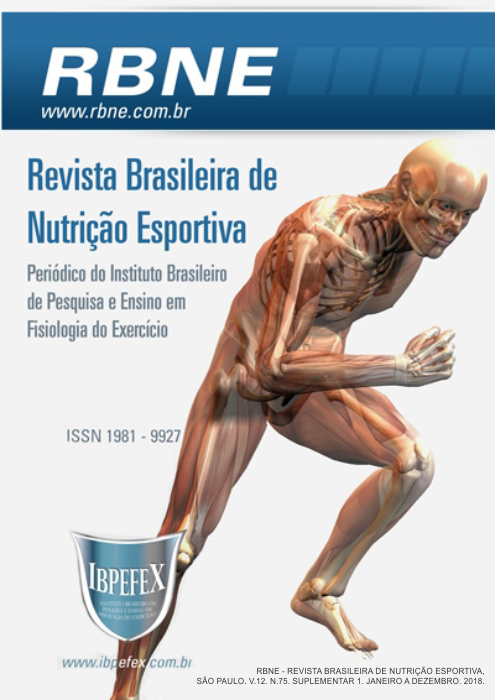Glicerol: ¿el nutriente dopante?
Resumen
El glicerol es un alcohol que se absorbe rápidamente. Su ingesta se ha utilizado con fines de hiperhidratación. El presente estudio tiene como objetivo discutir, desde el punto de vista literario, la presencia de datos que consolidan las funciones del glicerol como nutriente ergogénico y dopante. Esta es una revisión sistemática realizada con artículos seleccionados de las bases de datos electrónicas Science Direct, Library Collection of the Pan American Health Organization (OPS) Periodicals Capes, SciELO, PubMed y MEDLINE, utilizando los descriptores “glicerol”, “dopaje”, “hiperhidratación”. y "ejercicio", separados por el operador booleano "y". Se incluyeron artículos publicados desde 2002 hasta 2017 en múltiples idiomas. Los artículos seleccionados fueron aleatorizados, doble ciego y cruzados. Los estudios evaluados fueron de corta duración y presentaron participantes con diferentes características, como sexo, tipo de deporte practicado, edad, dosis y método de suplementación con glicerol. Es posible notar que los resultados de los estudios muestran que el glicerol es capaz de promover la hidratación y la retención de agua, sin embargo, pocos muestran mejora en el rendimiento. Sin embargo, existen discrepancias entre los datos presentados por los estudios. Por tanto, podemos concluir que no existen suficientes datos en la literatura para definir las funciones del glicerol en el metabolismo del deportista, especialmente en ejercicios realizados en calor con alta humedad, así como su interferencia en la detección de métodos de dopaje.
Citas
-Goulet, E.D.; Robert, R.A.; Labrecque, S.; Royer, D.; Dionne, I.J. Effect of glycerol-induced hyperhydration on thermoregulatory and cardiovascular functions and endurance performance during prolonged cycling in a 25 C environment. Applied Physiology, Nutrition, and Metabolism. Vol. 31. Num. 2. 2006. p. 101-109.
-Koehler, K.; Braun, H.; Marees, M.; Geyer, H.; Thevis, M.; Mester, J.; Schaenzer, W. Glycerol administration before endurance exercise: metabolism, urinary glycerol excretion and effects on doping‐relevant blood parameters. Drug testing and analysis. Vol. 6. Num. 3. 2013. p. 202-209.
-Koehler, K.; Braun, H.; Marees, M.; Geyer, H.; Thevis, M.; Mester, J.; Schaenzer, W. Urinary excretion of exogenous glycerol administration at rest. Drug testing and analysis. Vol. 3. Num. 11-12.2011. p. 877-882.
-Kreider, R.B.; Wilborn, C.D.; Taylor, L.; Campbell, B.; Almada, A.L.; Collins, R.; Cooke, M.; Earnest, C.P.; Greenwood, M.; Kalman, D. S.; Kerksick, C.M; Kleiner, S. M.; Leutholz, B.; Lopez, H. Lowery, L. M.; Mendel, R.; Smith, A.; Spano, M.; Wildman, R.; Willoughby, D. S.; Ziegenfuss, T.N.; Antonio, J. ISSN exercise & sport nutrition review: research recommendations. Journal of the International Society of Sports Nutrition. Vol. 7. Num. 1. 2010. p. 7.
-Magal, M.; Webster, M.J.; Sistrunk, L.E.; Whitehead, M.T.; Evans, R.K.; Boyd, J.C. Comparison of glycerol and water hydration regimens on tennis-related performance. Medicine and Science in Sports and Exercise. Vol. 35. Num. 1. 2003. p. 150-156.
-Marino, F.E.; Kay, D.; Cannon, J. Glycerol hyperhydration fails to improve endurance performance and thermoregulation in humans in a warm humid environment. Pflügers Archiv. Vol. 446. Num. 4. 2003. p. 455-462.
-Nelson, J.L.; Harmon, M.E.; Robergs, R. A. Identifying plasma glycerol concentration associated with urinary glycerol excretion in trained humans. Journal of analytical toxicology. Vol. 35. Num. 9. 2011. p. 617-623.
-Okano, M.; Nishitani, Y.; Dohi, M.; Kageyama, S. Effects of intravenous infusion of glycerol on blood parameters and urinary glycerol concentrations. Forensic science international. Vol. 262. 2016. p. 121-127.
-Polyviou, T. P.; Easton, C.; Beis, L.; Malkova, D.; Takas, P.; Hambly, C.; Pitsiladis, Y. P. Effects of glycerol and creatine hyperhydration on doping-relevant blood parameters. Nutrients. Vol. 4. Num. 9. 2012. p. 1171-1186.
-Van Rosendal, S. P.; Strobel, N. A.; Osborne, M. A.; Fassett, R. G.; Coombes, J. S. Hydration and endocrine responses to intravenous fluid and oral glycerol. Scandinavian journal of medicine & science in sports. Vol. 25. Num. S1. 2015. p. 112-125.
-Van Rosendal, S. P.; Coombes, J. S. Glycerol use in hyperhydration and rehydration: scientific update. In Acute Topics in Sport Nutrition. Vol. 59. 2013. p. 104-112.
-Van Rosendal, S.P.; Strobel, N. A.; Osborne, M. A.; Fassett, R. G.; Coombes, J. S. Performance benefits of rehydration with intravenous fluid and oral glycerol. Medicine and science in sports and exercise. Vol. 44. Num. 9. 2012. p. 1780-1790.
-Van Rosendal, S. P.; Osborne, M. A.; Fassett, R. G.; Coombes, J. S. Guidelines for glycerol use in hyperhydration and rehydration associated with exercise. Sports Medicine. Vol. 4. Num. 2. 2010. p. 113-139.
-WADA. World Anti-Doping Agency. World Anti-Doping Code. 2015.
-WADA. World Anti-Doping Agency. The prohibity lits 2016. Anti-doping code. Disponível em:<https://www.wada-ama.org/>. Acesso em: 07/11/2016.
-WADA. World Anti-Doping Agency. Decision limits for the confirmatory quantification of threshold substances, WADA threshold substances, WADA Technical Document–TD2014DL. 2014. Disponível em: <https://wada-main-prod.s3.amazonaws.com/resources/files/WADA-TD2014DL-v1-Decision-imits-for-the-Quantification-of-Threshold-Substances-EN.pdf> Acesso em: 07/11/2016
-Wingo, J.E.; Casa D.J.; Berger, E.M.; DEllis, W.O.; Knigth, J. C.; McClung, J.M.Influence of a pre-exercise glycerol hydration beverage on performance and physiologic function during mountain-bike races in the heat. Journal of athletic training. Vol. 39. Num. 2. 2004. p. 169.
Los autores que publican en esta revista aceptan los siguientes términos:
- Los autores conservan los derechos de autor y otorgan a la revista el derecho de la primera publicación, con el trabajo licenciado simultáneamente bajo una Creative Commons Attribution License BY-NC que permite compartir el trabajo con el reconocimiento de autoría del trabajo y la publicación inicial en esta revista.
- Los autores están autorizados a celebrar contratos adicionales por separado, para la distribución no exclusiva de la versión del trabajo publicado en esta revista (por ejemplo, publicar en un repositorio institucional o como capítulo de un libro), con reconocimiento de autoría y publicación inicial en esta revista.
- Se permite y se anima a los autores a publicar y distribuir su trabajo en línea (por ejemplo, en repositorios institucionales o en su página personal) en cualquier momento antes o durante el proceso editorial, ya que esto puede generar cambios productivos y aumentar el impacto y la cita del trabajo publicado (Consulte El Efecto del Acesso Abierto).






